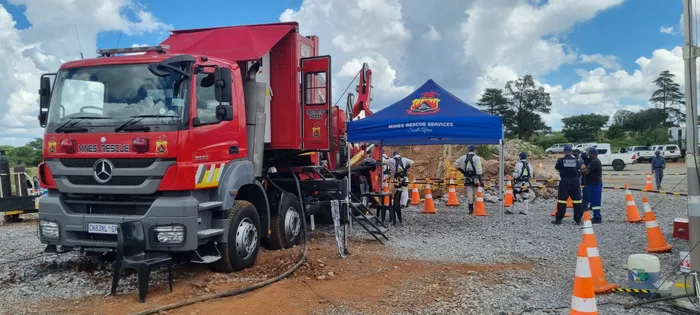Stilfontein mine rescue: how SA's innovative rescue technology aided in operation

This remarkable rescue was enabled by a locally designed and manufactured mobile rescue winder, equipped with world-first capabilities, including the ability to operate to a depth of 3km.
South Africa’s engineering prowess has been hailed for the role it played in the rescue of 246 individuals from the Stilfontein mine tragedy.
78 people lost their lives tragically at the Stilfontein mine, the tragedy underscored the complexities of illegal mining in South Africa.
Within three days, however, 246 individuals were rescued from the same perilous shaft.
This remarkable rescue was enabled by a locally designed and manufactured mobile rescue winder, equipped with world-first capabilities, including the ability to operate to a depth of 3km.

“The Mobile Mines Rescue Winder (MMRW) performed flawlessly and offers a glimmer of hope amidst the devastating loss,” said Russell Moore, the executive chairperson of Gauteng-based Tech Edge Group, which was responsible for the winder’s conception, design and manufacture.
“The loss of life at Stilfontein is a profound tragedy that left us deeply saddened. However, our MMRW demonstrated South Africa’s capacity to develop world-class solutions and contribute to a safer global mining future,” he said.
The rescue
On Friday, January 10, the Gauteng High Court ordered the rescue of miners who had been trapped for over three months in shafts 10 and 11 of the former Buffelsfontein Gold Mine at Stilfontein.
The mine had closed in 2013 when its operations were no longer financially viable.
Mines Rescue Services (MRS) South Africa, the owner and operator of a Tech Edge MMRW, led the rescue operation.
Tech Edge MD Bannister Erasmus’s phone rang just before 8pm on Sunday, January 12.
On the line was MRS’ CEO Mannas Fourie, asking Erasmus to have a team on-site at Stilfontein early the next morning.
Erasmus said the ground around the shaft had been somewhat cleared over the weekend and that after on-site tests of the MMRW, the first cage of people was brought to the surface at about midday from a depth of 1.4km.
The MMRW’s live camera feeds, from below the cage, inside the cage and on top of the cage, gave the surface team three different views of the interior of the shaft, while the communication system allowed messages to be relayed between the miners and the rescue team.
Although the cage’s recommended passenger count is six, Erasmus said that most of the miners were so emaciated that around 11 people could be accommodated per trip.
“The relief on the faces of the miners brought to the surface was humbling,” he said.
Emergency workers were on-site to treat the rescued miners. Those healthy enough were arrested, while the frail were sent to hospital under police guard.
Both Moore and Erasmus said that had it not been for the MMRW, which was designed to move on both national roads and extremely rough terrain, the rescue would not have been possible.
“For any other machine to have operated on the site, a concrete foundation would first have had to be laid,” Moore said.
“The immense time spent on research and development in bringing the MMRW to fruition paid off, it worked seamlessly,” Erasmus added.
The rescue operation ended late on Wednesday, January 15.
The conception of the MMRW
The MMRW’s development was inspired by the 2010 Chilean mining disaster, where a lengthy rescue operation highlighted the need for more efficient and mobile rescue equipment.
When Moore became involved in Tech Edge in 1992, it had been manufacturing custom-made winders for the mining industry for more than 60 years.
In 1993, the company’s focus shifted to pioneering solutions for the mining industry.
When 33 miners were trapped in Chile’s San Jose mine after a massive rockfall, a standard Tech Edge winder was airlifted to the disaster site as part of Murray & Roberts’ response to the Chilean government’s call for assistance.
“Despite several countries with expert mining skills being involved in the rescue operation, it took 69 days to eventually retrieve the miners, who initially survived on emergency rations and water from a spring and radiators.
“The incident got me thinking about how a comparable situation would be handled in South Africa. I realised we needed to develop better equipment and that this equipment would need the capabilities to go anywhere – and to do so quickly,” Moore said.
“The idea for the MMRW germinated.”
Once Moore’s ideas were fleshed out by Tech Edge’s team, he took the design to MRS, with which they had a good working relationship, and MRS commissioned the company to complete the MMRW project.
The winder was tested and commissioned at one of the world’s deepest mines, Gold Fields’ South Deep Twin Shafts near Johannesburg in January 2021.
It was then licensed by the Department of Mineral Resources and Energy (DMRE).
Subsequently, Tech Edge developed another winder for shallower mines (1km depth capabilities), which MRS also acquired.
“A similar machine was delivered to a company sinking a diamond mine in Botswana,” Moore said.
BUSINESS REPORT
Police warned of consequences for ignoring calls to transfer Zama zamas to hospitals
Report claims Zama zamas syndicates sell products to legitimate companies and fund political campaigns
Spat continues between police and union over allegations regarding blasting of shaft 10 at Stilfontein mine
Mining Indaba 2025: industry faces critical challenges amid investment hopes